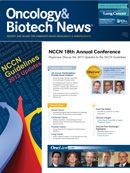Sunshine or Sunset? Only Time Will Tell
Andrew L. Pecora, MD, discusses possible drawbacks to the Physician Payment Sunshine Act, which was passed in 2010 by Congress as part of the Patient Protection and Affordable Care Act.
Andrew L. Pecora, MD
Editor-in-Chief
Oncology & Biotech News
Chief Innovations Officer, Professor, and Vice President of Cancer Services John Theurer Cancer Center at Hackensack University Medical Center
Much has been written about the need for greater transparency in the area of financial relationships between physicians and manufacturers of drugs, medical devices, and biologics. The underlying concern is that any financial relationship broadly defined—including any transfer of value greater than $10.00 or $100.00 in aggregate over 1 year (eg, a meal or a car ride more than 20 miles)—might influence a physician to inappropriately prescribe a medication or use a device. It is believed that public reporting will prevent this without adverse consequence and aid government enforcement of US federal anti-kickback statutes. In general terms, this is hard to argue with, until one considers the potential unintended consequences.
The Physician Payment Sunshine Act (Sunshine Act) was passed in 2010 by Congress as part of the Patient Protection and Affordable Care Act (ACA). Starting this August, manufacturers must begin to keep accounting for any transfer of value exceeding $10.00 (with some exceptions), and the live reporting will begin in 2014.
This concept of transparency has its roots in the Government in the Sunshine Act, a law passed in 1976 that affects the operations of the federal government. Here, the goal was to increase the information to the public regarding how the government makes decisions as part of the Freedom of Information Act. What is not well known is that the new law requires reporting for any MD, DO, or RN, including those not directly involved in clinical patient care, such as medical writers, and also includes clinical trials. With regard to medical writers, it is not clear how to define value of service provided, and for those funded to do clinical trials, accounting will be a challenge. Charity care is exempt, as are several other items. In summary, the law was passed for the intended purpose of reducing healthcare expenditures in the United States paid for by the Centers for Medicare & Medicaid Services (CMS).
Now, let us consider one of the unintended consequences. If we are trying to reduce the cost of healthcare, and a big component of the cost comes from manufacturers, the question becomes, what will compliance with the Sunshine Act cost manufacturers in time and money? The CMS believes the cost will be $269 million the first year, and $180 million every year thereafter. The true numbers will likely be much higher when one considers the actual reporting requirements.
The law mandates that there is a line item reporting of the transfer of value. As an example, if a physician attends a conference sponsored by a manufacturer and happens to be giving a lecture for that manufacturer, and has a glass of wine and eats some of the food being passed around, the reporting would require a breakdown of the transfer of value for giving the lecture, travel, and the food.
To make it more interesting, imagine another physician is coming to attend the lecture. If he or she decides to have a glass of wine valued at $8.00 they are fine, but heaven forbid they eat a crab cake—now the total transfer of value is $12.00, and that physician will have his or her name listed publically in a national database as having received a transfer of value from a manufacturer. However, say after the first bite of the crab cake, it is cold and the physician doesn’t finish it. Does the transfer of value now get recalculated? Will the manufacturer be required to have calorie counters onsite to determine how many glasses of wine and crab cakes each physician consumes?
To finish this story, if the physician goes home and, having learned something new from the lecture, prescribes a drug that the manufacturer supporting the event sells, did he or she do it because of the content of the lecture, or because of enjoying a crab cake with the glass of wine? Think about it: a glass of wine is not a problem; add a crab cake, however, and your name is listed on a national database. The real question is, why were the thresholds for reporting set so low? Why is line-item accounting required? Based on what data? The transfer of information from manufacturers to clinicians is critical for discovery and patient care. It appears to me, while well intended, Sunshine might be Sunset.




